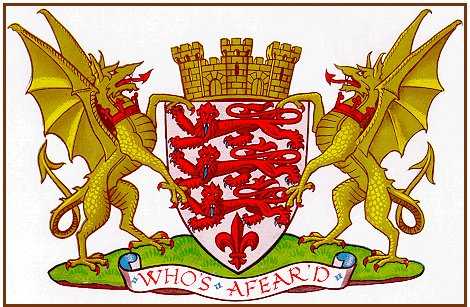Dorset: Difference between revisions
Knorrepoes (talk | contribs) m (Text replacement - "====Official blazon====" to "===Official blazon===") |
Knorrepoes (talk | contribs) m (Text replacement - "[[Category:England" to "50 px|link=United Kingdom[[Category:England") |
||
| Line 24: | Line 24: | ||
[[Category:British County Councils]] | [[Category:British County Councils]] | ||
[[Category:England]] | [[File:england.jpg|50 px|link=United Kingdom]][[Category:England]] | ||
[[Category:Granted 1950]] | [[Category:Granted 1950]] | ||
Revision as of 15:04, 9 December 2017
| Heraldry of the World |
| British heraldry portal Civic heraldry of the United Kingdom |
|
DORSET
Official blazon
Arms : Argent three Lions passant guardant in pale and in base a Fleur-de-Lys Gules; the Shield ensigned with a Mural Crown towered Or.
Supporters : On either side a Dragon wings elevated and addorsed Or gorged with a Saxon Crown Gules.
Motto : 'WHO'S AFEAR'D'
Origin/meaning
The arms were officially granted on February 21, 1950.
In 1889 the County Council (when first created) debated the question of a seal and settled on three lions passant, taken from the oldest seal of the town of Dorchester, surrounded by the words 'The Seal of the County Council of Dorset'. After some discussion before the Second World War, the County Council applied to the College of Arms for a coat of arms in 1949, which was granted on February 21, 1950.
The three lions represent England and lions are found in the arms of Dorchester, Bridport, Lyme Regis, Weymouth and Blandford Forum. Lions' faces are in the coat of arms of Shaftesbury. The fleur-de-lis appears in the shields of of Dorchester, Bridport, Wareham and Shaftesbury. The mural crown is designed to echo the insignia of the Dorset Regiment and the Society of Dorset Men and the golden dragon of Wessex or Wyvern represented the ancient kingdom of Wessex.
The motto of 'Who's afear'd' was one of four originally suggested, including Lord Shaftesbury's suggestion; 'Excellence where Beauty Reigns'. 'Who's afear'd' was adopted by the Society of Dorset Men in 1905 at the suggestion of Thomas Hardy. It was converted to Dorset dialect by them in 1908, and was suggested to the County Council by a Colonel C.D.Drew, then curator of the Dorset County Museum.
Contact and Support
Partners:
Your logo here ?
Contact us
© since 1995, Heraldry of the World, Ralf Hartemink 
Index of the site
Literature : Information provided by the Dorset County Council













